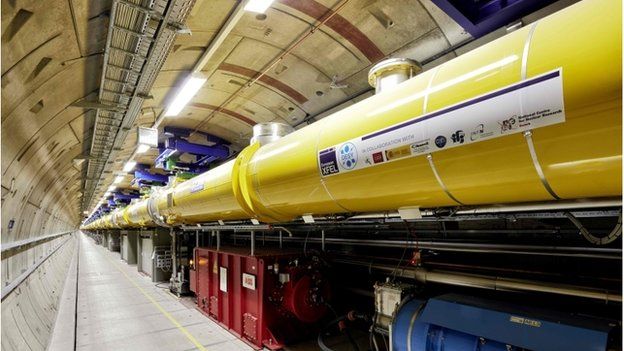vostok
Well-Known Member

One of the most powerful X-ray machines ever built has officially opened in the German city of Hamburg.
The facility, which has cost more than a billion euros to build, will be used to study the detailed structure of matter, atom by atom
It is called the European X-ray Free Electron Laser (XFEL).
The researchers anticipate fundamental discoveries that lead to new medical treatments and novel materials, to name just two possibilities.
The XFEL will begin operations with 11 nations as members of its consortium.
Britain, which has supplied equipment to the facility, is expected to sign commitment papers to join the group before the end of the year.
Prof Robert Feidenhans'l is the MD of the non-profit company established to run the facility.
"It's a fantastic and exciting day for us to open the European XFEL for operation after more than eight years of construction," he told Friday's inauguration ceremony.

The electrons are produced under Hamburg and are injected into
the machine to produce an X-ray beam that is received at Schenefeld
"I now declare we are ready to take data; we are ready to meet the challenge of
getting groundbreaking results."
The machine is a superconducting linear accelerator that is housed in a 3.4km-long tunnel
complex some 40m beneath Hamburg and the nearby town of Schenefeld.

The European XFEL has been a major engineering undertaking
It works by accelerating bunches of electrons to almost light-speed, before then throwing them down a slalom course controlled by a system of magnets, known as undulators.
As the electrons bend and turn, they emit flashes of X-rays; and as the particles interact with this radiation, they also bunch even tighter.
Their compact configuration not only intensifies their light emission but gives it coherence as well. In essence, the X-rays are "in sync" and have the properties of laser light.
The beam will penetrate and detail at the atomic scale whatever is put in its path.
This could be the protein molecules that drive our bodies or the catalyst materials used to produce industrial chemicals.

- At the head of the XFEL, bunches of electrons are first sped up to near-light-speed in a super-cold, evacuated accelerator
- The particles are directed down long undulators - magnetic systems that produce a slalom course for the electrons
- As they wiggle back and forth in the undulators, the fast-moving electrons emit very bright X-ray flashes
- The particles interact with this great sea of X-rays and begin to organise themselves into even tighter groupings
- This intensifies the brilliance of their emission and gives it coherence - the X-rays are "in sync" and laser-like
- Having done their job, the electrons are siphoned off, leaving the X-ray flashes to hit their experimental targets

German Education and Research Minister, Johanna Wanka, visits the XFEL control room
Many nations around the world use circular machines called synchrotrons that do a very similar job.
But the light generated by the XFEL is about a billion times brighter than those facilities. What also sets the XFEL apart is the super-fast time structure in its flashes.
The machine will deliver trillions (1,000,000,000,000) of X-ray photons in a pulse lasting just 50 femtoseconds (0.000,000,000,000,05 sec), and it can repeat this 27,000 times a second.
It allows for time-resolved investigations that are beyond what is possible in standard synchrotrons. For example, scientists will use a jet to stream their samples in front of the beam, priming them with another laser so that chemical reactions are triggered at just the right moment to be caught by the pulses.

Artwork: The US machine was used to map the atomic structure of a large protein involved in th
e transmission of African sleeping sickness
The conventional X-ray light sources also use pure crystals of the biological molecules they want to study. These can be very difficult to make - impossible in some cases.
"The huge hope for XFEL is that we will be able to do single particle imaging. So, you just put a stream of your protein complex or virus into the beam and you'd have enough photons that an individual biological entity would scatter those photons for you to get the shape of it," explained Oxford University's Prof Elspeth Garman, who sits on the committee that will allocate scientists experimental time in Hamburg.
Prof Garman already fulfils this role for the American machine at the National Accelerator Laboratory in Stanford University, California. This facility is now heavily oversubscribed and so the addition of the European option - which is also a step on in capability - will be most welcome, she says

The LPD is expected to take some punishment in the beam
Germany not only hosts the XFEL, it has provided most of the funding and the technology. The other members are Russia, Denmark, France, Hungary, Italy, Poland, Slovakia, Spain, Sweden and Switzerland.
When the project was green-lit in 2007, the UK looked certain to become a consortium member, but then stepped away from participation after the financial crash.
This situation has now changed again and following a brief discussion about whether it should build its own machine, Britain is expected to formally climb aboard the German-led project in the coming weeks.
The in-out uncertainty, however, has not stopped UK technical contributions.
British engineers have made an advanced camera called the Large Pixel Detector which has been installed in Hamburg ready for the first raft of experiments. It operates at a frame rate of 4.5MHz - 4.5 million pictures per second.

A swathe of discoveries across biology, chemistry, and physics are expected
Matthew Hart was the lead engineer on the LPD at the Science and Technology Facilities Council's (STFC) Rutherford Appleton Laboratory (RAL) near Oxford.
"The LPD captures the pattern of the X-rays after they've scattered through whatever it is the scientists have put in the beam. Its imaging surface is about half a metre by half a metre," he told BBC News.
"It's something we've been working on for 10 years, and it's incredibly bespoke. It has to run really fast, handle really intense levels of X-rays but at the same time capture very small signals as well; and have very low noise."
The laboratory is currently making a second detector, or at least the replacement parts for one.
The XFEL's high-energy beam is so intense it actually destroys samples as it probes them, and it is expected the cameras that record the action will also become degraded over time.
Japan, too, operates a free electron laser, although its flash rate is not as high as the Stanford machine and a long way short of the Hamburg capability.
The European XFEL is not an EU institution. However, many of the scientists who come through the complex will be in receipt of EU grants dispersed under the bloc's research budget, Horizon 2020.

Not yet a formal member, but the UK flag was displayed at Friday's inauguration
(http://www.bbc.com/news/science-environment-41117442)


